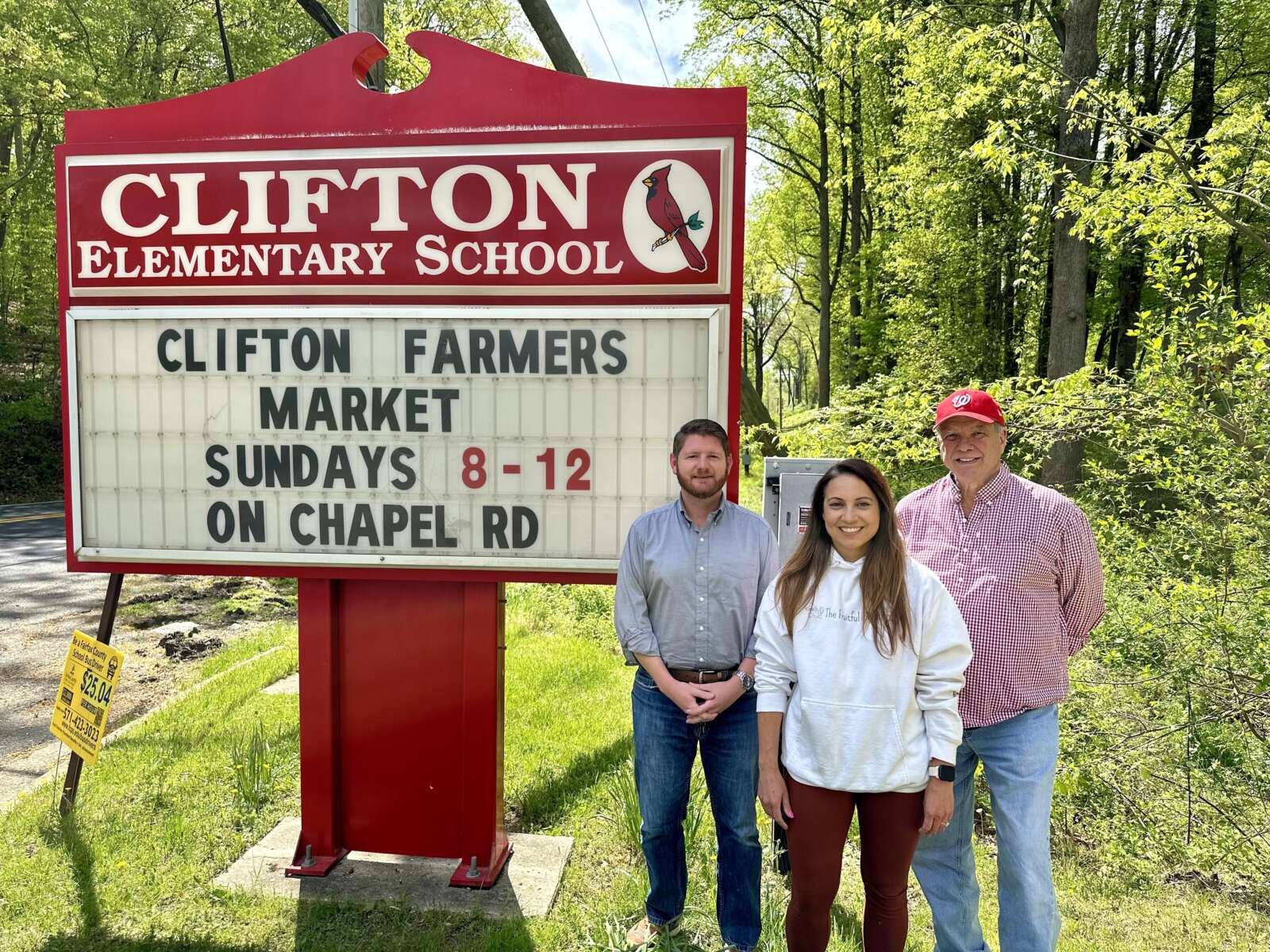
Nearly 14 years after Clifton Elementary School shuttered, its sign has been repurposed.
The sign now serves as a bulletin for local organizations, businesses, and community groups to promote events such as farmers markets, cultural celebrations and educational workshops.
The Fairfax County School Board voted 9-2 on July 8, 2010 to close Clifton Elementary School, citing declining enrollment, high renovation costs and poor well-water quality.
Clifton-area residents filed a lawsuit to keep the school open, arguing that the school board’s decision was arbitrary and based on misrepresented facts.
After a year of legal battles, the Virginia State Supreme Court sided with the school board, allowing the elementary school to officially close on June 21, 2011 — a few years shy of its 60th anniversary.
The site has since remained empty, which didn’t sit well with recently elected At-Large School Board Member Kyle McDaniel. So, he teamed up with his colleague on the board, Sandy Anderson, as well as Clifton Mayor Tom Peterson and Fairfax County Public Schools staff to turn the school’s old sign into a community notice board.
“It was a simple thing to do that didn’t cost us any money and helped the community,” he told FFXnow. “It also was a gesture to start trying to mend fences with the community that is still upset about the school closure.”
Anderson, who represents the Springfield District on the school board, expressed gratitude for the community’s support and enthusiasm for the sign’s revival.
“I’m so glad that FCPS has been able to take the small first step to reintegrate this property back into the Clifton community,” she said in a press release. “I look forward to continued progress.”
“Clifton is a special community, and I am proud to represent it on the school board,” McDaniel remarked. “This is a first step on a journey to repurposing more of the Clifton Elementary School site for more community use.”
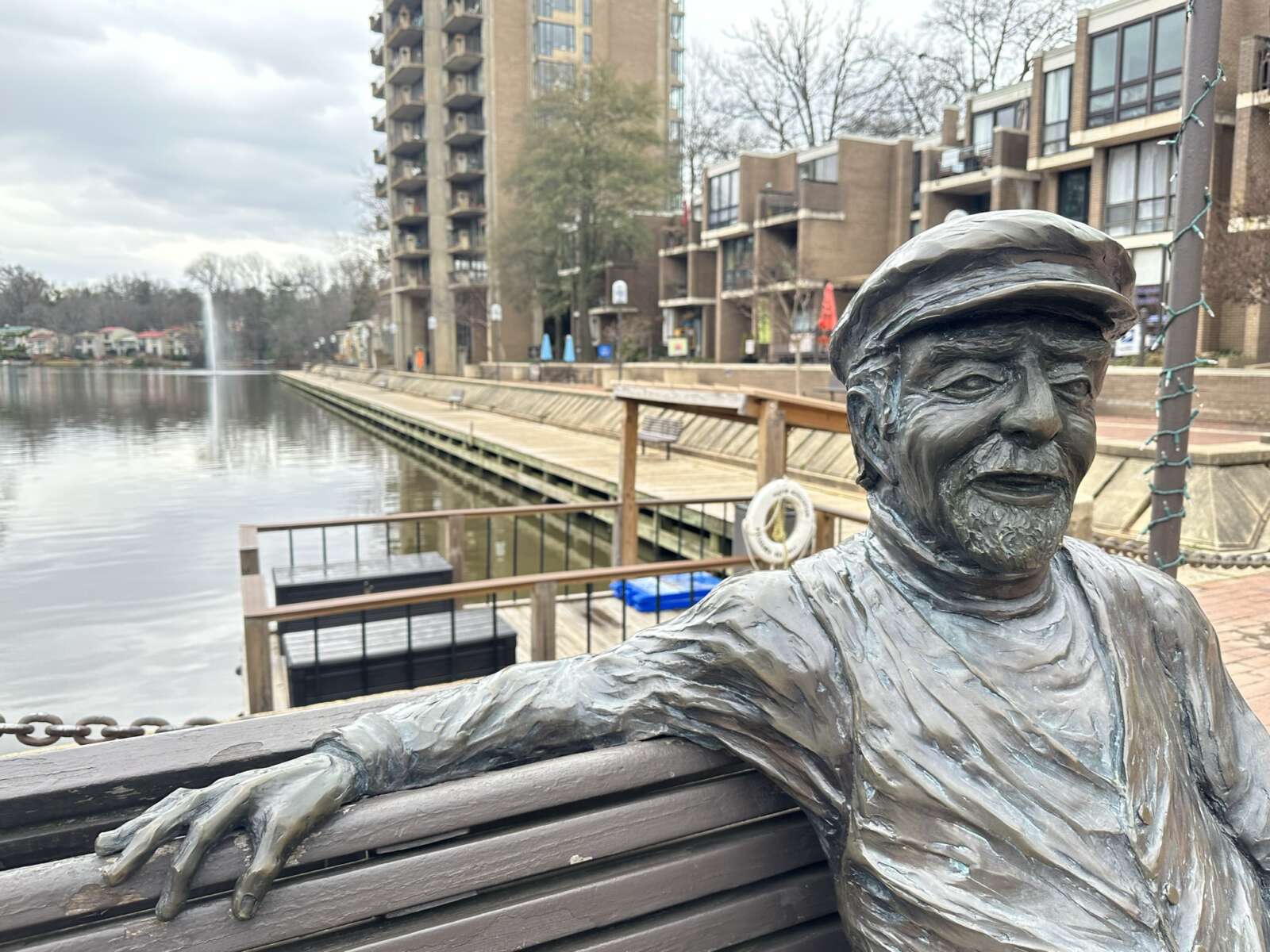
Reston is sort of an odd duck — an Epcot-like planned community named for its founder Robert E. Simon — and anyone curious about how it came together can learn all about it at a walking tour this weekend.
The Reston Museum has opened registration for a historic walking tour.
The tours are scheduled for 10 a.m.-11 a.m. on Saturday, April 20, April 27, May 18 and May 25.
“Learn about the founding of Reston through our historic walking tour,” the Reston Museum said. “Learn about how Reston’s founding principles were implemented and the early history of Reston’s art and architecture.”
Tickets are $10 for non-museum members or free for museum members.
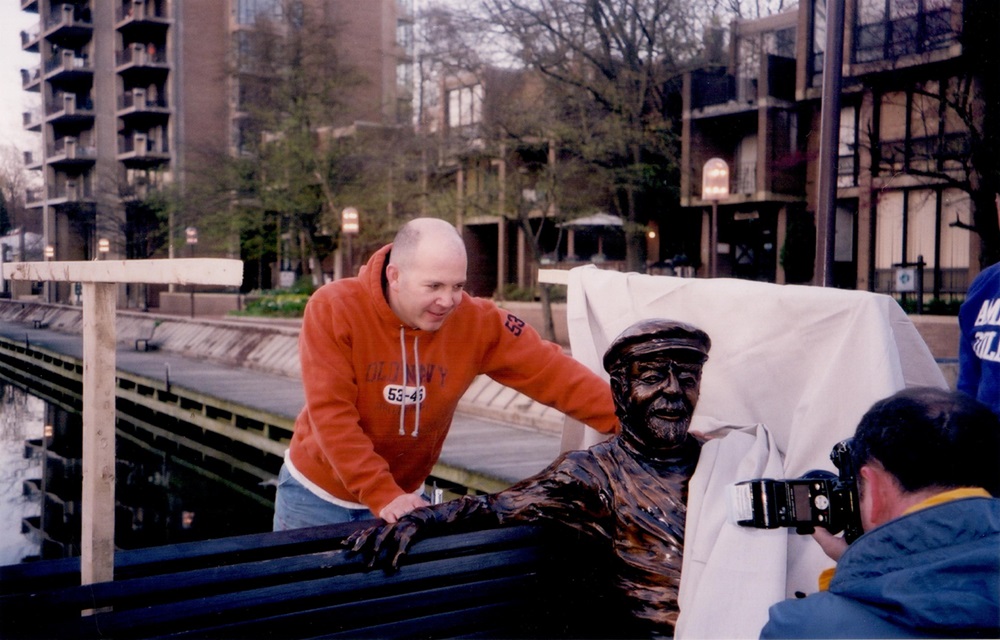
It’s been 20 years since an iconic sculpture honoring Reston’s founder Robert E. Simon was unveiled at Lake Anne Plaza.
To celebrate the anniversary of the sculpture’s installation, Reston Museum is hosting an event featuring its creator, artist Zachary Oxman. The event will take place at Reston Community Center Lake Anne (1609-A Washington Plaza North) next Wednesday, March 13 at 7 p.m.
“We are thrilled to host Mr. Oxman for our March program,” Reston Museum Executive Director Alexandra Campbell said. “It’s a perfect start to our Founder’s Day 20th-anniversary celebrations, highlighting the installation of the ‘Bronze Bob’ sculpture. We will also feature photographs from the sculpture’s original unveiling throughout March at the museum.”
The event will also feature longtime Restonian Cheryl Terio-Simon, widow of Bob Simon Jr. and author of the book “Community is What It Is All About: An Ode to Lake Anne.”
The artist talk is free, but registration is required.
Known officially as “Untold Stories” and informally as “Bronze Bob,” the statue will get a full anniversary celebration next month as part of Founder’s Day, which will be held on April 6 this year.
Oxman’s sculpture has become a “cherished symbol of Reston’s rich heritage,” Reston Museum says.
A Carnegie Mellon University alumnus with a bachelor’s of fine arts degree, the artist is also the brain behind Convergence, a sculpture at the Aperture Apartments in Reston Station.
“His career and contributions to public art underscore a deep connection to community and storytelling through sculpture,” Reston Museum said.
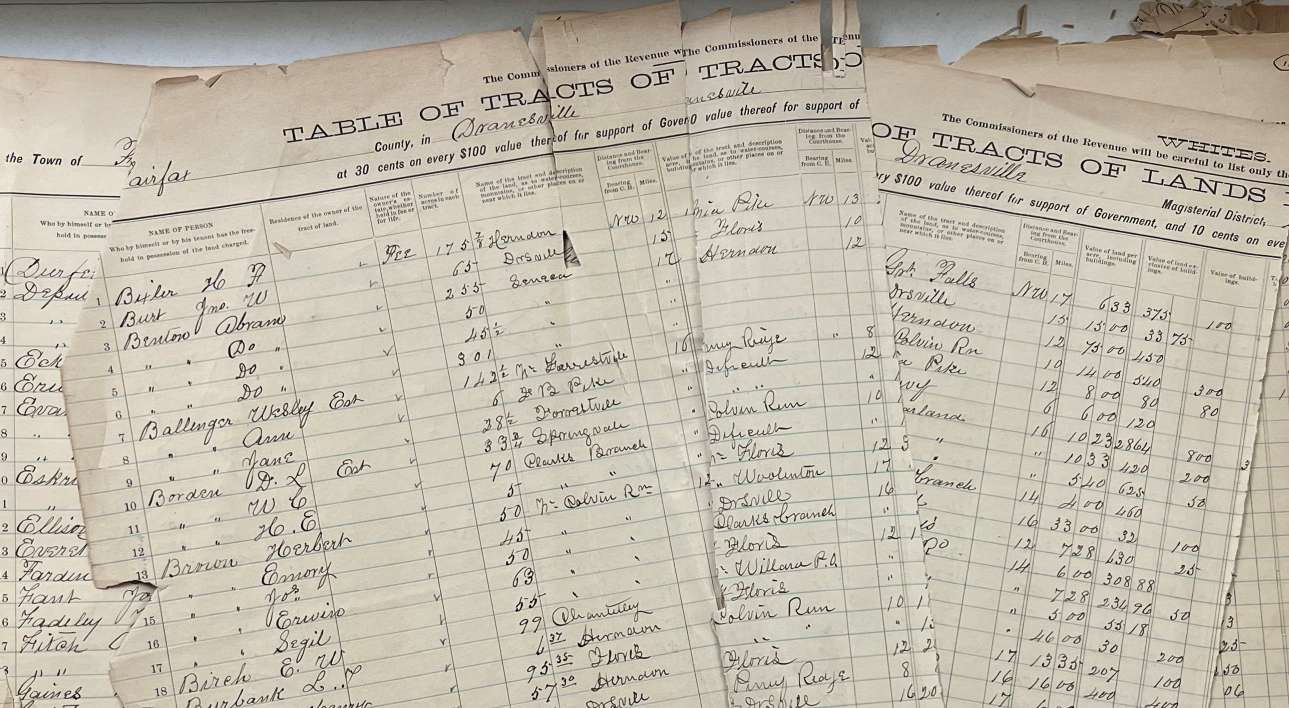
(Updated at noon) Fairfax County landowners interested in comparing their current tax assessment with what they might’ve been charged at the tail end of the 19th century will soon be able to find that information online.
Local land tax books from 1891 and 1896 are among the records that the Fairfax County Circuit Court Clerk’s Office plans to preserve and digitize after receiving a nearly $21,270 state grant.
Announced by the Library of Virginia last Thursday (Feb. 29), the award will also be used to preserve marriage license books from 1867-1895 and 1896-1928, an 1880 Federal Census Book, and “Deed Book Liber O-6 1904,” according to the clerk’s office.
“We’re very excited to receive this grant from the Library of Virginia,” Fairfax County Circuit Court Clerk Chris Falcon said. “I am thankful we have such a great collection of records and want to make sure they are properly maintained. It is our collective responsibility to preserve this invaluable resource for future generations.”
The documents are currently stored at the Historic Records Center in the Historic Fairfax Courthouse (4000 Chain Bridge Road, Suite 1600), which houses records dating back to the county’s formation in 1742 through the early 1900s.
According to a spokesperson for Falcon’s office, the records center’s archivist, Georgia Brown, and her team prioritize records for conservation based on their current condition, historical importance, the frequency with which they’re used for research and other criteria.
“These records are very fragile and have never been digitized,” the spokesperson said. “Once our archivist and her team have determined which records best fit the criteria, a representative from the Library of Virginia chooses from the provided records which would be most appropriate for the grant.”
The Library of Virginia awarded more than $3.2 million in grants this year from its Circuit Court Records Preservation (CCRP) program, which started in 1992 to help local courts preserve records and make them more accessible. The Library of Virginia is required by state law to maintain public records created before 1912.
Over the past three decades, the CCRP has given out more than 2,000 grants totaling over $36 million.
Last year, the Fairfax County Circuit Court was awarded almost $22,420 to preserve records that included a map used in the 1950s to determine the boundaries between Fairfax County and Alexandria.
“The process of conservation usually takes approximately six months, and the digitization process will be done simultaneously,” the clerk’s office spokesperson said.
Once digitized, this year’s preserved records will be publicly available online through the circuit court’s Court Public Access Network, a subscription-based database.
Correction: This story originally identified Heather Bollinger as the Historic Records Center’s archivist. Bollinger previously served as the historic records manager but is no longer with the center. Georgia Brown is currently the lead archivist.

Restonians now have a chance to own a piece of their community’s history.
Reston Museum, which is located at Lake Anne Plaza, will hold a raffle over the next month for a chance to win vintage plates that were used at the Bowman House during the early years of Reston’s formation.
Tickets are $5 for one raffle entry and $20 for five entries. They are available for purchase throughout March.
All proceeds from the raffle will benefit Reston Museum, a nonprofit organization that aims to preserve Reston’s past, inform the present and influence the future.
The museum is open Tuesday through Saturday at 1639 Washington Plaza.
Located at what is now an office park on Bowman Green Drive, the Bowman house was built in 1941 and operated as a distillery. The house was used by Robert Simon, Reston’s founder, in the 1960s, as he began planning Reston. It was renovated into an office park in 1984, according to Reston Museum.

The Town of Vienna’s future library will bear a name with close ties to its past.
Fairfax County Public Library’s Board of Trustees unanimously approved “Vienna-Carter” as the new name for Patrick Henry Library at its meeting on Wednesday (Feb. 14). The name change will officially take effect once the library reopens after an expansion project that’s expected to start later this year and finish in fall 2026.
The vote inspired applause at the back of the George Mason Regional Library meeting room where the board convened. Among those clapping were Hoyt and Dee Dee Carter, a grandson and cousin, respectively, of Patrick Henry Library’s new namesakes, William and Lillian Carter.
“I’m very thrilled,” Dee Dee Carter said after the meeting adjourned. “I’m elated because it was unanimous. Nobody did a pushback, and I’m glad they’re in favor of it.”
Aware of the upcoming renovation, the Carters, who still live in Vienna, proposed last year that Patrick Henry Library be renamed after their family, who were instrumental in getting Fairfax County to integrate the facility when it launched in 1962.
Before Patrick Henry was established, Vienna’s only library was a one-room building on Maple Avenue that only served white residents. One day in the 1950s, the Vienna Library Association’s board of trustees even came to the Carters’ home and took back books that a white woman had checked out for their children, including Hoyt Carter’s father.
That incident spurred the Carters to start an informal “Friends of the Library” group in 1958 that met in their living room, according to a family story recounted in Christopher Barbuschak and Suzanne LaPierre’s book “Desegregation in Northern Virginia Libraries.”
With an interracial membership that included Kenton Kilmer, the son of poet Joyce Kilmer, the friends’ group successfully desegregated Vienna’s library, overcoming the opposition of the library association’s president to revise its charter to allow all patrons regardless of race.
Dee Dee Carter says one of her cousins, Sharon Honesty, was one of the first African American patrons to use Patrick Henry when it opened in Vienna’s Maple Avenue Shopping Center in 1962. The library moved to its current site at 101 Maple Avenue East in 1971.
“We were talking about Blacks being able to go in and use the library and use books from the library, so I feel that it’s a wonder to have this now happen,” Hoyt Carter said of Patrick Henry getting renamed after his grandparents.
Though the vote was unanimous, some board members reported getting questions and emails asking why the name change was being considered.
While the renaming wasn’t subject to a public hearing, FCPL Director Jessica Hudson said community members had several opportunities to weigh in at board meetings, including before the board approved an update to its facility naming policy last November.
The change had gotten the support of Hunter Mill District Supervisor Walter Alcorn and some Vienna Town Council members, though the council didn’t take an official stance, according to FCPL Board Chair Brian Engler.
Dee Dee Carter told FFXnow that she hasn’t heard anyone object to the new name, which was initially proposed to be “Carter-Vienna.” FCPL’s policy requires library names to reference their geographical location, and the board ultimately decided that the location should go first.
Suzanne Levy, the board’s vice chair and Fairfax City representative, expressed hope that the renaming will draw attention to the library system’s history.
“We’re not hiding what the county used to do,” she said. “It opens discussion and shows that we’re moving forward.”
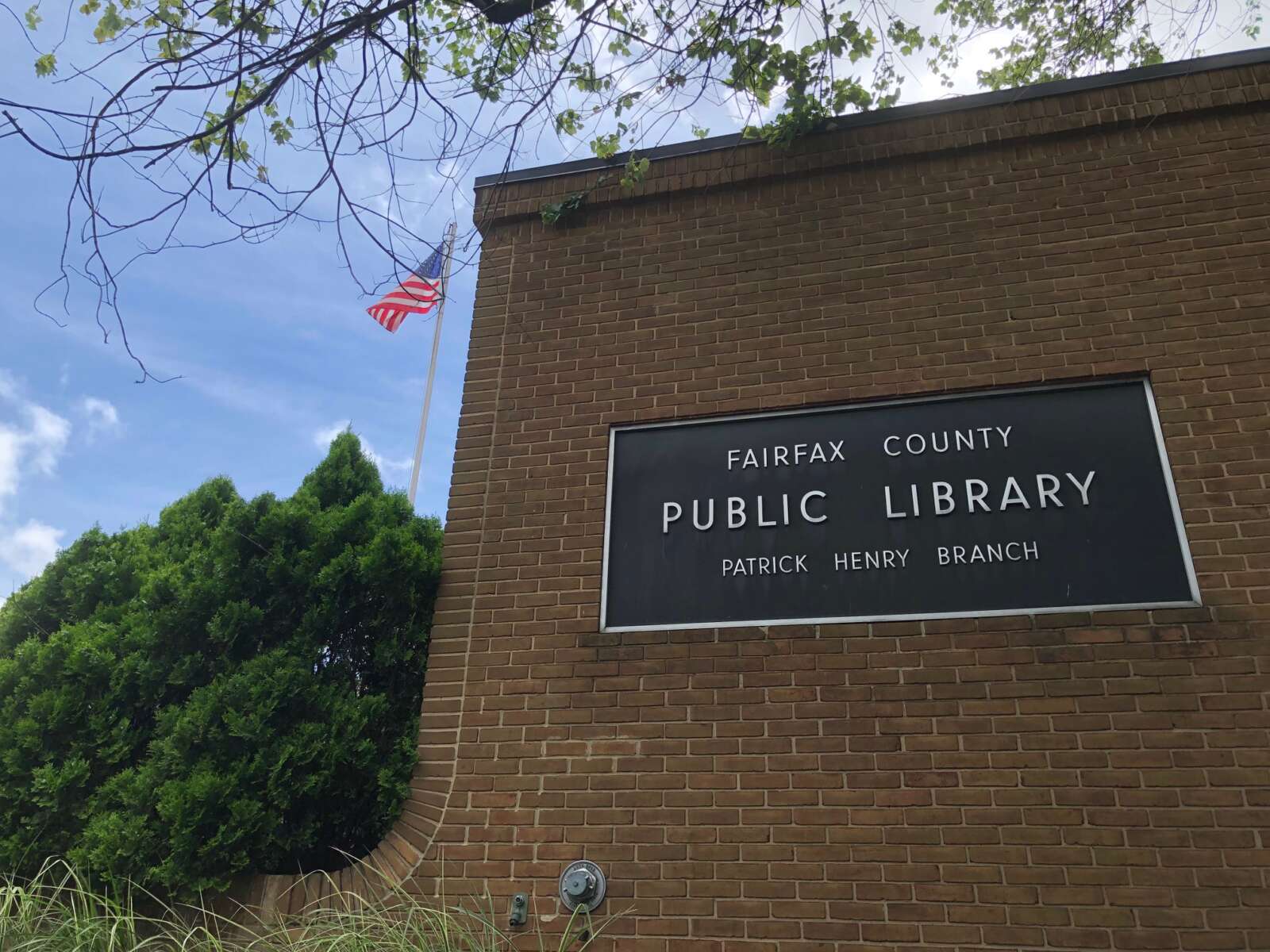
A new look could come with a new name for Patrick Henry Library.
With a major renovation on the horizon, the Fairfax County Public Library’s board of trustees is set to vote next Wednesday (Feb. 14) on whether to rename the Vienna facility after William and Lillian Carter, who co-founded the nonprofit friends’ group that has supported the library for over half a century.
Living members of the Carter family requested the name change last year as a recognition of their ancestors’ efforts to ensure Patrick Henry would be integrated when it launched in 1962, according to Library Board Chair and Braddock District Trustee Brian Engler.
“Mr. Carter was a founding member of the nonprofit Friends of the Library group in Vienna, which advocated for a County library facility within the Town to serve all residents,” Engler told FFXnow. “At that time, library services were only available to white residents. After receiving the inquiry, the Library Board first reviewed its policies regarding facility naming conventions and is now at a point where it can have full board discussion on the request.”
The request came to the board of trustees on Sept. 13, 2023, prompting a re-consideration of FCPL’s policy for naming facilities, according to the board packet for next week’s meeting, which will take place at 7 p.m. at George Mason Regional Library (7001 Little River Turnpike) in Annandale.
Previously updated in 2020, the existing policy permitted renaming proposals from residents of a library’s service area “if the benefits of the name change outweigh the costs such a name change could generate.” However, the new name had to reflect the library’s geographic location.
The board approved a revision on Nov. 8 that added the option for libraries to “also include the name of a group or individual, living or deceased, who has made a significant contribution” to FCPL as a whole or to that individual branch. A reference to the branch’s location must still be included.
As a result, FCPL staff are recommending that Patrick Henry be renamed the “Carter-Vienna Library” after it’s rebuilt.
Vienna’s first public library operated out of a one-room building at 101 Maple Avenue East from 1897 to 1962. Spurred by the advocacy of the Friends of Vienna Library group that the Carters helped found, Fairfax County started Patrick Henry Library as a shopping center storefront before its current building opened in 1971.
The original library was relocated to 164 Mill Street NE in 1969 and has been preserved as a museum run by Historic Vienna Inc.
Last renovated in 1995, the Patrick Henry Library building is now nearing the end of its usable life, according to FCPL. The planned overhaul will pair an approximately 18,000-square-foot, one-story library with a 209-space, three-level parking garage partially funded by the Town of Vienna.
According to the board’s Feb. 14 agenda, county staff currently anticipate construction on the project to begin this fall or winter, putting the new library on track to open in fall 2026.
“The County has additionally committed to opening a temporary library space within the Town of Vienna to continue providing resident services during the demolition and construction period,” FCPL staff wrote.
Given its eventual demolition, staff recommended that Patrick Henry Library’s name change, if approved, not take effect until the new building opens.
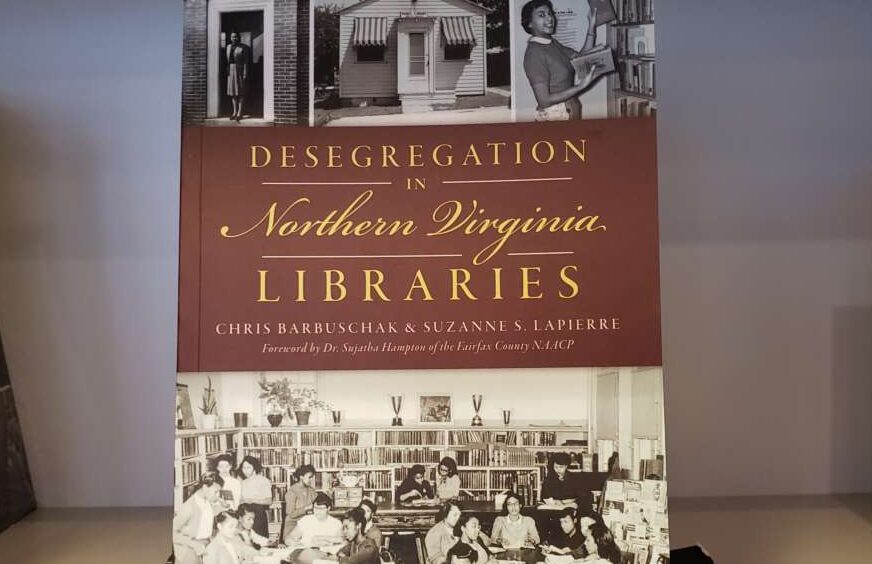
The battle to integrate Fairfax County Public Library and other library systems in the region will be the focus of a Reston-based event for Black History Month.
Authors Chris Barbuschak and Suzanne LaPierre will offer a look at the overlooked history of segregated library services in Northern Virginia at the Feb. 21 event organized by Reston Museum. It’s slated to begin at 7 p.m. at Reston Community Center’s Lake Anne facility (1609-A Washington Plaza North).
The program focuses on the librarians’ book, “Desegregation in Northern Virginia Libraries.”
“We are thrilled to have Mr. Barbuschak and Ms. Lapierre speak at our February program about their book,” Reston Museum Executive Director Alexandra Campbell said. “Those interested in reading the book in advance can purchase the book at the museum or the day of the program. It is an insightful book and I encourage everyone to read it.”
The book highlights how libraries were inaccessible to Black residents — even after the landmark Supreme Court case Brown v. Board of Education that found segregation to be unconstitutional. Ultimately, civil rights activists used protests and lawsuits to gain equitable library services.
The 208-page book, which was published last January, is available online. Registration for the upcoming author talk is available through Reston Museum’s website.
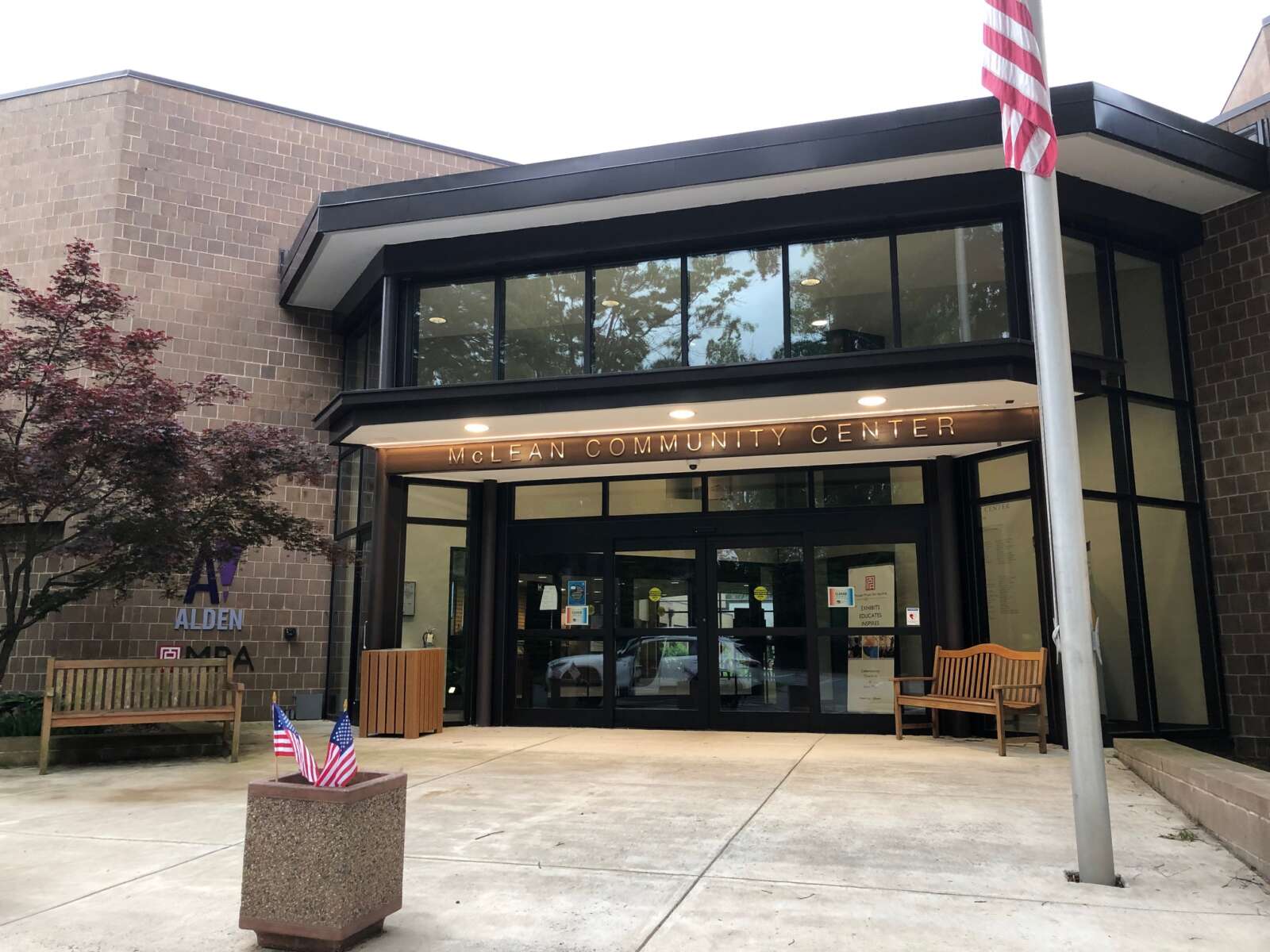
(Updated at 4:35 p.m. on 1/30/2024) The McLean Community Center will cap this year’s Black History Month with an appearance by one of the students who helped integrate public schools in Little Rock, Arkansas — a landmark moment in the Civil Rights Movement.
The youngest member of the “Little Rock Nine,” Carlotta Walls LaNier will visit the Alden Theatre at 1234 Ingleside Avenue on Sunday, Feb. 25 for a free author talk and book signing, preceded by a V.I.P. meet-and-greet.
Sponsored by the nonprofit Fairfax Library Foundation, the meet-and-greet will start at 12:15 p.m. and include refreshments. Currently on sale for $75 through Eventbrite, tickets are available for only 50 people, who will also get reserved seating for the subsequent author talk.
LaNier will then speak from 2-3 p.m. in a Fairfax County Public Library event open to the general public before signing copies of her 2009 memoir “A Mighty Long Way: My Journey to Justice at Little Rock Central High School.”
Now 81 years old, LaNier was just 14 when she and eight other teens became the first Black students to attend Little Rock Central High School in 1957, three years after the U.S. Supreme Court ruled that segregation in public schools is unconstitutional.
Initially turned away on Sept. 3, 1957 by the Arkansas National Guard, which had been called in by governor Orval Faubus, the students weren’t able to actually enter the previously all-white school until Sept. 23, 1957. They were escorted by Little Rock police officers through a mob that began rioting, forcing the students to be quickly evacuated.
It took federal intervention, with President Dwight Eisenhower ordering an escort of Army troops, for the Little Rock Nine to make it into Little Rock Central High School for their first full day of classes on Sept. 25.
Becoming the school’s first Black, female graduate in 1960, LaNier is now 81 years old and has lived in Colorado since 1962, according to the Colorado Sun. In recent years, she has raised concerns about the country regressing when it comes to civil rights and the inclusiveness of education, particularly on history.
“I am concerned that they [young people] are not getting all that I got, even in a segregated school. Parents are paying taxes for good schools, and they’re not getting them,” LaNier told the Denver Urban Spectrum in 2022. “It’s disheartening to know that these kids are not receiving the type of education that even I received in a segregated and integrated environment.”
Correction: This story has been updated with the accurate location of Carlotta LaNier’s events. Fairfax Library Foundation initially announced that they would be held at Dolley Madison Library.
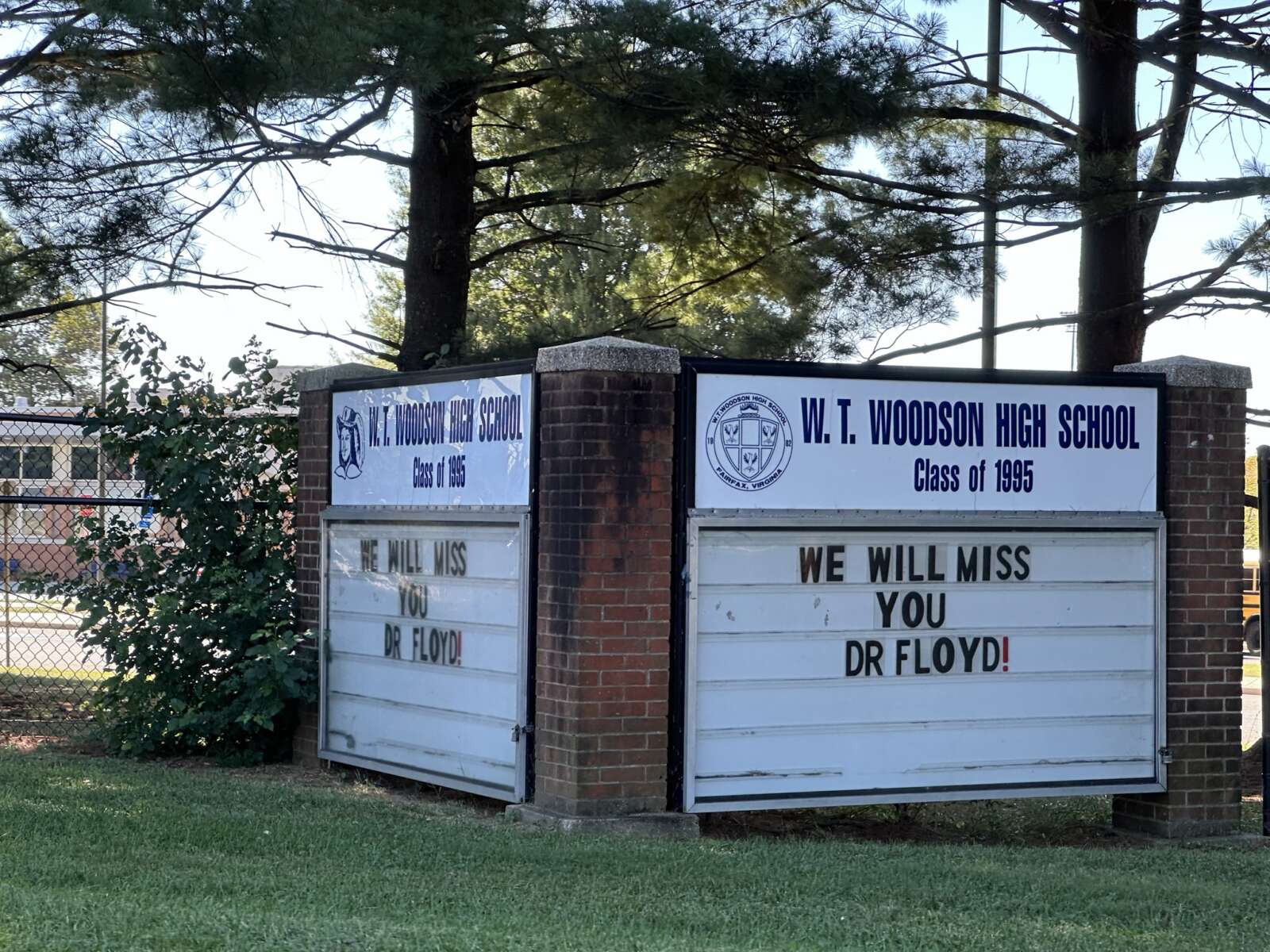
Woodson High School may soon drop “W.T.” from the beginning of its name.
The Fairfax County School Board launched a formal process last week to consider renaming the school just outside Fairfax City, adding it to a growing list of local institutions and landmarks whose monikers have been reevaluated in recent years.
Crediting students with advocating for change, the school board has suggested adopting scholar Dr. Carter G. Woodson — the “Father of Black History” — as the school’s namesake in place of Wilbur Tucker Woodson, whose long tenure as Fairfax County Public Schools superintendent included opposition to desegregation.
“I truly believe it will be and can be a remarkable moment for our county, for a solemn reckoning of our county and our Commonwealth’s segregationist past and a reconciliation and a healing,” said Braddock District School Board Representative Megan McLaughlin, who introduced the proposal at a work session on Sept. 12.
The proposal was co-sponsored by six other school board members, including all three at-large members and three other members — Karl Frisch (Providence), Ricardy Anderson (Mason) and Laura Jane Cohen (Springfield) — who also represent portions of the Woodson area.
Now serving over 2,400 students, Woodson was the largest school in Fairfax County and Virginia when it originally opened its doors in fall 1962 — just over a year after W.T. Woodson retired in June 1961, according to FCPS.
Appointed superintendent from 1929 to 1961, Woodson oversaw FCPS as it evolved from a smattering of small schoolhouses into one of the state’s largest districts, growth fueled by the county’s population boom following World War II.
When he died in 1983, a Washington Post obituary described Woodson as “a gradualist” who believed Black and white students should be integrated over time, starting with first graders, rather than all at once.
However, in a 1959 letter to a school board member, Woodson called desegregating schools “most unfair” because it would force “social adjustments to which so many parents strongly object.” In addition to fearing “social mixing,” he warned integration would reduce political and financial support for public schools.
According to McLaughlin, concerns about Woodson High School’s name have cropped up in the past, but it wasn’t given the same priority as schools with clear nods to the Confederacy, like J.E.B. Stuart (now Justice High School), Robert E. Lee (renamed after Rep. John Lewis) and Mosby Woods (now Mosaic Elementary School).
That changed when an FCPS staff member found the 1959 letter while researching the system’s history with segregation, confirming that Woodson’s resistance to integration reflected his personal beliefs, not just adherence to state policy.
“The school board may consider a change in the name of an existing school or facility to ensure an inclusive, respectful learning environment,” McLaughlin told FFXnow. “It’s not inclusive when you have the name of an individual on a building that we now have a document that shows that he believed in the merits of segregation.”
Noting that several of her family members have attended Woodson, including her husband, brothers and children, McLaughlin stressed her desire to approach the renaming process with “humility,” even as she hopes the community will support Carter G. Woodson as an alternate name. Read More

